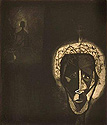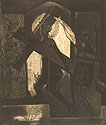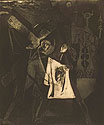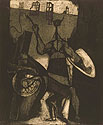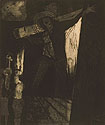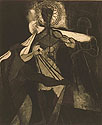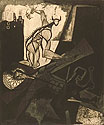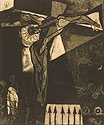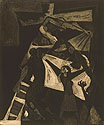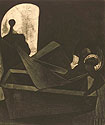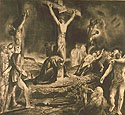Introduction
"In My Father's House ... " is an exhibition of twenty-three fine prints relating to the passion, death, and resurrection of Christ, i.e., the "Preludes to Easter." Selected from Georgetown's collections of more than 7,200 fine prints, the exhibition is divided into three parts: the first, a presentation in mid-20th century iconography of the fourteen "Stations of the Cross;" the second, a further consideration of the crucifixion itself; and third, the first word of Christ's resurrection.
The Stations of the Cross
Part I opens with Georgetown's set of Dick Swift's fourteen intaglio prints of the Stations of the Cross produced in 1957 and 1958. They are called intaglios because the artist uses several different methods in working up their images on the copper plates from which they were printed, including etching, drypoint, soft ground, aquatint, etc., as needed to obtain their desired tonal and textural results. Note how Swift has retold the timeless story of the Stations as a 20th century drama, replete with the references to the injustices and sufferings of its wars.
In viewing these prints note both the action taking place and the intaglio techniques and iconography used in creating them. In No.1, for example, Swift uses a heavy aquatint in the background where Pilate washes his hands to highlight Christ's expression of utter disbelief and chagrin over the spectacle. Note also Swift's recurring use of textiles pressed into the soft grounds applied to his copper plates to produce the visual sense of cloth, of vegetation growing in some of the foregrounds, and in the use of recurring geometric designs in a number of his backgrounds.
Moving on to Swift's iconography, he leaves no doubt as to when or where the unfolding drama of the Stations is taking place. Note the high rise buildings in Nos. 6, 7, and 11; the cut of Mary's dress in No. 4; and Veronica's silk stockings and high heels in No. 6, and again in No. 11.
With the action commencing in No. 2, Swift introduces his first two of several monstrous figures of evil, one on either side of Christ as they thrust the cross into his hands. The double horned figure of inhumanity on the left will reappear again horseback in Nos. 3 and 4; standing with spear in hand in No. 6; holding a whip over the fallen Christ in No. 7; and again on horseback in No. 9 as a cohort raises a whip as Christ falls for the third time. And finally, he appears again in No. 11, hammering the nail through Christ's right hand into the wood of the cross.
In that same No. 11, Swift introduces a new figure-death, as the uniformed rifle-toting soldier, swastika patch on shoulder, driving the nail through Christ's feet into the cross. In No. 12, still more figures appear-three prisoners behind a barbed wire enclosure on the left, and in the lower right, Picasso's bull is arriving by tank from Guernica to revel in the spectacle of the crucifixion.
The Crucifixion
Part II features George Bellows' 1923 lithograph, "Crucifixion of Christ." It is based on a drawing he did for the publication of Arthur Conan Doyle's piece, "I Saw Him Crucified," in the September, 1922, issue of Hearst's International Magazine. It was a letter purportedly written by a Roman soldier to his uncle reporting on the facts of Christ's crucifixion as he had heard them from a centurion who was there.
Surrounding the Bellows print are the following three woodcuts by Robert F. McGovern who teaches at The Philadelphia College of Art, and who is noted for the quality of his expressive woodcuts. Note their spiritual intensity.
Part II ends with Isac Friedlander's remarkable wood engraving of 1930 entitled "Crucifixion," done not long after his arrival in New York. Friedlander was an immigrant artist from Latvia, and cousin of Joseph Hirshhorn's.
The Resurrection
The exhibition reaches its peak here in a print by Lucas Vorsterman, a student of Rubens', and arguably the finest engraver of his master's paintings. Born in 1595, he took up engraving at age twelve, and joined Rubens' studio in 1617. Under Rubens' guidance, he developed an unequaled ability in capturing the expressiveness and nobility of Rubens' figures. Here is his print, "Holy Women at the Empty Tomb," which he completed around 1620, dedicating it to two of Antwerp's important matrons.
The exhibition comes to a close with two color woodcuts by Irving Amen.
As the lead title of the exhibition implied, and as the selection of its twenty-three prints attempts to show, Christ's passion, death, and resurrection is a timeless and recurring drama taking place in our midst. May its "Preludes to Easter" encourage us to reflect on the fulness of its meaning as it continues to play out in my Father's House of cultural and religious pluralities where Irving Amen reminds us that His many children dwell.
Easter 1999
Joseph A. Haller, S.J.
The Crucifixion
Morgan, William E. C., 1903-1979
1925
Wood engraving
135 x 172 mm
A student of Henry Tonks at London's Slade School, Morgan won the Prix de Rome medal in 1924 in wood engraving, and its three-year scholarship to the British School in Rome. It was there in his first year that he did this engraving of the crucified Christ dying in a rural landscape in the Italian hill country. Note that he peopled it with a traveler on horseback riding off in the distance to a neighboring town, a farmer plowing his field, with another talking to the print's lone woman while keeping an eye on his pigs, and a kneeling monk tending to the needs of a man fallen ill, all going about their normal activities, oblivious to the momentous drama playing out in their midst-a phenomenon which will turn up again in the last print in Part II of the exhibition.
Christ Is Laden with the Cross (Second Station)
Swift, Dick, b. 1918
1958
Intaglio
445 x 377 mm
Christ is aided by Simon of Cyrene (Fifth Station)
Swift, Dick, b. 1918
1958
Intaglio
445 x 377 mm
Christ Falls the Second Time (Seventh Station)
Swift, Dick, b. 1918
1958
Intaglio
445 x 377 mm
Preaching to the Women of Jerusalem (Eighth Station)
Swift, Dick, b. 1918
1958
Intaglio
445 x 377 mm
Christ Is Stripped of His Garments (Tenth Station)
Swift, Dick, b. 1918
1958
Intaglio
445 x 377 mm
Crucifixion (over New York City)
Friedlander, Isac, 1890-1968
1930
Wood engraving
304 x 192 mm
In this print we find the dying Christ crucified on the arms of a builder's construction crane overlooking New York's business district with an elevated train pulling into its station, the nearby river docks and a passing ship, the neighboring buildings with their billboards, and the streets below filled with passing cars, busses, and pedestrians rushing by, oblivious to the drama playing out high above them, not unlike the people Morgan observed and placed in that Italian hill country print seen in the introduction to this exhibit.
Holy Women at the Empty Tomb
Vorsterman, Lucas, 1595-1642
c. 1620
Engraving
354 x 455 mm
The scene is taken from the 28th Chapter of St. Matthew's Gospel with "Mary Magdelene and the other Mary" having come to inspect Christ's tomb "as the first day of the week was dawning." They were met by the angel who had already rolled back the stone. Noticing their expressions and those of the other women who accompanied them, Vorsterman's angel attempted to reassure them with the following words seen flowing in Latin from his lips:
"Do not be afraid. I know that you are looking for Jesus, the crucified. He is not here. He has risen exactly as he promised. Come see where he was laid."
It was then that the holy women realized that Easter had dawned, and the angel charged them to go quickly and tell the disciples that he would see them in Galilee.


